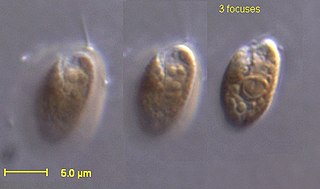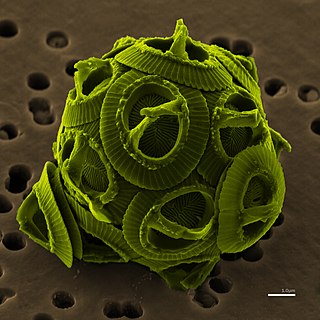| Cryptomonadaceae | |
|---|---|
 | |
| Cryptomonas platyuris | |
| Scientific classification | |
| Domain: | |
| Division: | |
| Class: | |
| Order: | |
| Family: | Cryptomonadaceae Ehrenberg 1831 |
| Genera | |
| Synonyms | |
| |
Cryptomonadaceae is a family of Cryptophyta in the order Cryptomonadales. [1]
| Cryptomonadaceae | |
|---|---|
 | |
| Cryptomonas platyuris | |
| Scientific classification | |
| Domain: | |
| Division: | |
| Class: | |
| Order: | |
| Family: | Cryptomonadaceae Ehrenberg 1831 |
| Genera | |
| Synonyms | |
| |
Cryptomonadaceae is a family of Cryptophyta in the order Cryptomonadales. [1]

The cryptomonads are a group of algae, most of which have plastids. They are traditionally considered a division of algae among phycologists, under the name of Cryptophyta. They are common in freshwater, and also occur in marine and brackish habitats. Each cell is around 10–50 μm in size and flattened in shape, with an anterior groove or pocket. At the edge of the pocket there are typically two slightly unequal flagella. Some may exhibit mixotrophy. They are classified as clade Cryptomonada, which is divided into two classes: heterotrophic Goniomonadea and phototrophic Cryptophyceae. The two groups are united under three shared morphological characteristics: presence of a periplast, ejectisomes with secondary scroll, and mitochondrial cristae with flat tubules. Genetic studies as early as 1994 also supported the hypothesis that Goniomonas was sister to Cryptophyceae. A study in 2018 found strong evidence that the common ancestor of Cryptomonada was an autotrophic protist.

Chromista is a proposed but polyphyletic biological kingdom, refined from the Chromalveolata, consisting of single-celled and multicellular eukaryotic species that share similar features in their photosynthetic organelles (plastids). It includes all eukaryotes whose plastids contain chlorophyll c and are surrounded by four membranes. If the ancestor already possessed chloroplasts derived by endosymbiosis from red algae, all non-photosynthetic Chromista have secondarily lost the ability to photosynthesise. Its members might have arisen independently as separate evolutionary groups from the last eukaryotic common ancestor.

The cryptophyceae are a class of algae, most of which have plastids. About 230 species are known, and they are common in freshwater, and also occur in marine and brackish habitats. Each cell is around 10–50 μm in size and flattened in shape, with an anterior groove or pocket. At the edge of the pocket there are typically two slightly unequal flagella.

German submarine U-131 was a Type IXC U-boat of Nazi Germany's Kriegsmarine during World War II.

Cryptomonadales is an order of Cryptophyta containing the families Cryptomonadaceae and Hilleaceae.

Pyrenomonadales is an order of Cryptophyta.

The cryptomonads-haptophytes assemblage is a proposed but disputed monophyletic grouping of unicellular eukaryotes that are not included in the SAR supergroup. Several alternative names have been used for the group, including Hacrobia ; CCTH ; and "Eukaryomonadae".
Katablepharis is a genus of single-celled eukaryotes comprising five to six species. They are heterotrophic and live in both freshwater and seawater. They have two flagella and a feeding apparatus consisting of a mouth and two arrays of microtubules.

Rhodomonas is a genus of cryptomonads. It is characterized by its red colour, the square-shaped plates of its inner periplast, its short furrow ending in a gullet, and a distinctly shaped chloroplast closely associated with its nucleomorph. Historically, Rhodomonas was characterized by its red chloroplast alone, but this no longer occurs as its taxonomy has become increasingly based on molecular and cellular data. Currently, there is some debate about the taxonomic validity of Rhodomonas as a genus and further research is needed to verify its taxonomic status. Rhodomonas is typically found in marine environments, although freshwater reports exist. It is commonly used as a live feed for various aquaculture species.
Geminigera /ˌdʒɛmɪnɪˈdʒɛɹə/ is a genus of cryptophyte from the family Geminigeraceae. Named for its unique pyrenoids, Geminigera is a genus with a single mixotrophic species. It was discovered in 1968 and is known for living in very cold temperatures such as under the Antarctic ice. While originally considered to be part of the genus Cryptomonas, the genus Geminigera was officially described in 1991 by D. R. A. Hill.
Komma caudata is a cryptomonad, and the only described species in the genus Komma, although four or five more species may exist. Its cells are 4.5–5.5 μm wide by 7–10 μm long and bear two unequal flagella.

The kathablepharids or katablepharids are a group of heterotrophic flagellates closely related to cryptomonads. First described by Heinrich Leonhards Skuja in 1939, kathablepharids were named after the genus Kathablepharis. This genus is corrected to Katablepharis under botanical nomenclature, but the original spelling is maintained under zoological nomenclature. They are single-celled protists with two anteriorly directed flagella, an anterior cytostome for ingesting eukaryotic prey, and a sheath that covers the cell membrane. They have extrusomes known as ejectisomes, as well as tubular mitochondrial cristae.
Plants+HC clade is a group of eukaryotes proposed by Burki et al. (2008).

Geminigeraceae is a family of cryptophytes containing the five genera Geminigera, Guillardia, Hanusia, Proteomonas and Teleaulax. They are characterised by chloroplasts containing Cr-phycoerythrin 545, and an inner periplast component (IPC) comprising "a sheet or a sheet and multiple plates if diplomorphic". The nucleomorphs are never in the pyrenoid, and there is never a scalariform furrow. The cells do, however, have a long, keeled rhizostyle with lamellae (wings).

Cryptista is a clade of alga-like eukaryotes. It is most likely related to Archaeplastida which includes plants and many algae, within the larger group Diaphoretickes.

Pyrenomonadaceae is a family of cryptomonads which includes three or four known genera. They are distinguished from other cryptomonads by their nucleomorphs being imbedded into the pyrenoid, and the presence of distinctive pigment phycoerythrin 545.

Chroomonadaceae is a family of cryptomonads first recognized by Clay et al in 1999 as including genera Chroomonas, Falcomonas, and Komma. Following a molecular phylogenic study in 2002, Hemiselmis was also placed within the Chroomonadaceae. Today, the family is generally recognized as sister to the Pyrenomonadaceae.
Hilleaceae was one of the three families of Cryptomonads proposed by R.W. Butcher in 1967, who included only the genus Hillea. It has appeared in at least two other cryptomonad classification systems since then. However, as Hillea has yet to be successfully cultured, its validity as a genus remains uncertain.
Cryptochrysis is a formerly recognized genus of cryptomonads first proposed by Adolf Pascher in 1911. He initially treated it as the sole genus in family Cryptochrysidaceae, but later treated it as a member of the Cryptochrysideae subfamily of Cryptomonadaceae, along with Rhodomonas, Chroomonas, and Cyanomonas. In 1967, R.W. Butcher relegated the group to a subgenus within Chroomonas.